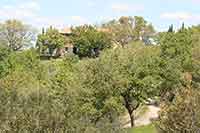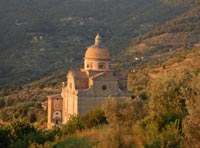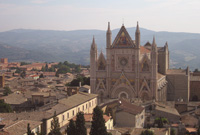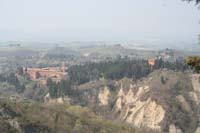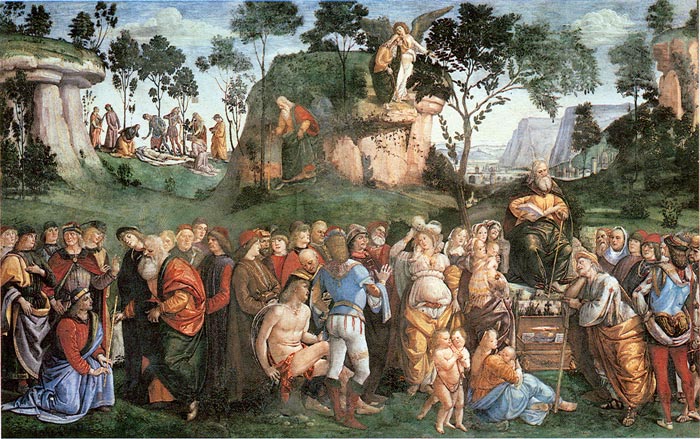 |
|||
Luca Signorelli (and Bartolomeo della Gatta), Testament and Death of Moses, oil on panel, 21.6 x 48 cm, Vatican City, Sistine Chapel, Rome |
|||
| Luca Signorelli, Testament and Death of Moses |
| Luca Signorelli trained under Piero della Francesca, and his earliest work reflects his debt to Piero, especially in the use of broad planes to model forms. But Signorelli rejected Piero's static figures and was most concerned with depicting the human body in action, an interest he may have acquired from the Florentine painter and sculptor Antonio Pollaiuolo. Among Signorelli's most important early works are the frescoes (late 1470s) in the Sacristy of the Basilica of the Holy House, Loreto, the Flagellation (1480-1481) in the Brera, Milan, the Testament and Death of Moses (ca. 1482) in the Sistine Chapel in the Vatican, Rome, the S. Onofrio altarpiece (1484) in the Cathedral Museum, Perugia, and the frescoes (mid-1490s) in the cloister of the Abbey of Monte Oliveto Maggiore near Siena. The Sistine Chapel is the best-known chapel in the Apostolic Palace, the official residence of the Pope in Vatican City. It is famous for its architecture and its decoration which has been frescoed throughout by the greatest Renaissance artists including Michelangelo, Perugino, Raphael, Bernini, Sandro Botticell and Luca Signorelli. Signorelli executed a single fresco in the Sistine Chapel, the Testament of Moses. Another, Moses and Zipporah, which has been usually ascribed to Signorelli, is now recognized as the work of Perugino. Signorelli worked in Rome from 1478–1484. He assisted in the decoration of the lower walls of the Sistine Chapel. The Testament of Moses is almost entirely of his hand. Signorelli must have had a considerable reputation by about 1483, when he was called on to complete the cycle of frescoes on the walls of the Sistine Chapel in Rome, left unfinished by Botticelli, Ghirlandaio, Perugino, and Rosselli. It's is not known why these four artists abandoned the work in 1482, but it has been suggested that they simply downed tools because of slow payment. Signorelli completed the scheme with distinction. The scenes on the right wall are the Moses's Testament by Luca Signorelli and the Punishment of Corah by Sandro Botticelli. [Biography of Luca Signorelli] |
| Moses's Testament and Death |
||
| The fresco is from the cycle of the life of Moses in the Sistine Chapel. It is located in the sixth compartment on the south wall. The Sistine Chapel takes its name from Pope Sixtus IV della Rovere (pontiff from 1471 to 1484) who had the old Cappella Magna restored between 1477 and 1480. The 15th century decoration of the walls includes: the false drapes, the Stories of Moses (south and entrance walls) and of Christ (north and entrance walls) and the portraits of the Popes (north and south and entrance walls). It was executed by a team of painters made up initially of Pietro Perugino, Sandro Botticelli, Domenico Ghirlandaio, Cosimo Rosselli, Luca Signorelli and their respective workshops, which included Pinturicchio, Piero di Cosimo and Bartolomeo della Gatta.[1] The subjects of the pictures were historical religious themes, selected and divided according to the medieval concept of the partition of the world history into three epochs: before the ten commandments were given to Moses, between Moses and Christ's birth, and the Christian era thereafter. They underline the continuity between the Old Covenant and the New Covenant, or the transition from the Mosaic law to the Christian religion.The work on the frescoes began in 1481 and was concluded in 1482. The fresco Moses's Testament and Death depicts the last episodes in the life of Moses. On the right sits the hundred-and-twenty-year-old Moses on a rise, holding his staff and with golden rays circling his head. At Moses's feet stands the ark of the Covenant, opened to show the jar of manna inside and the two tables of the law. In the left half of the picture Joshua is appointed Moses's successor. Joshua kneels before Moses, who gives him his staff. In the centre of the background we see Moses being led by the angel of the Lord up Mount Nebo, from which he will be able to look across to the Promised Land that by the will of God he will never enter. At the foot of the mountain we see him again, turning toward the left. His death is depicted in the background, in the land of Moab, where the children of Israel mourned him for thirty days. In 1508 Pope Julius II determined to readorn the camere of the Vatican Palace, and he summoned to Rome Signorelli, in company with Perugino, Pinturicchio and Bazzi (Sodoma). They began operations, but were shortly all superseded to make way for Raphael, and their work was taken down. Luca returned to Siena, living afterwards for the most part in Cortona. He continued constantly at work, but the performances of his closing years were not of special mark.[2] |
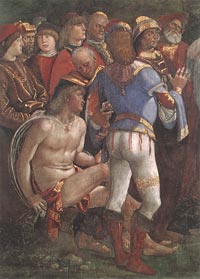 |
|
|
||
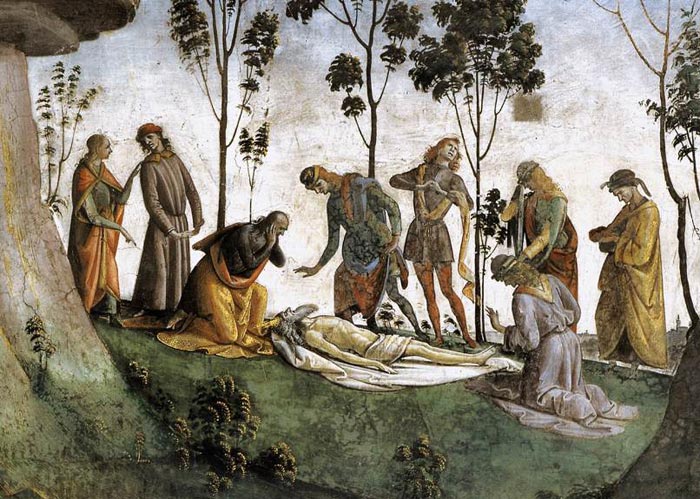 |
||
Luca Signorelli, Moses's Testament and Death (detail), 1481-82, fresco, Cappella Sistina, Vatican, Rome |
||
Holiday accomodation in Tuscany | Podere Santa Pia | Artist and writer's residency
|
||||
Podere Santa Pia |
Podere Santa Pia, garden view, April |
View from Podere Santa Pia
on the coast and Corsica |
||
 |
 |
|||
| The towers of San Gimignano | Montalcino |
Siena, Duomo |
||
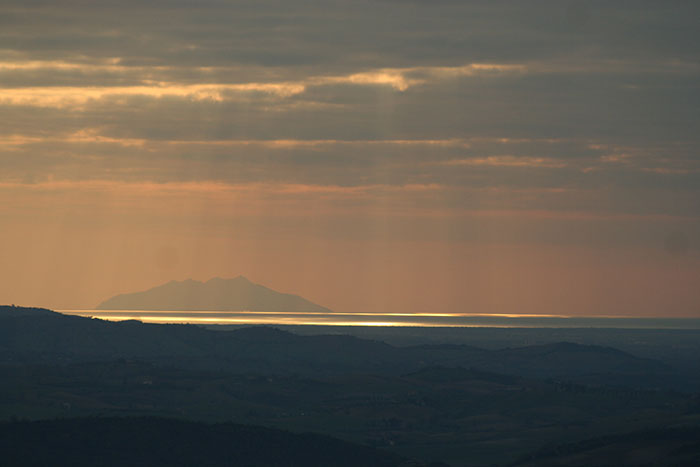 |
||||
Podere Santa Pia, with a breathtaking view over the Maremma hills, the Tyrrhenia coast and Montecristo, an island in the Tyrrhenian Sea and part of the Tuscan Archipelago
|
||||
[1] Signorelli must have been just over thirty, when he became involved in the decoration of the Sistine Chapel. Luca's name does not appear among the group of Tuscan and Umbrian artists (Cosimo Rosselli, Botticelli, Ghirlandaio and Perugino) who, on 27 October 1481, signed the contract for the decoration of the side walls of the famous chapel, which were to be frescoed with Biblical scenes. But Vasari is absolutely certain of his involvement and his hand is evident in some details of the huge scene of Moses's Testament and Death. The painting, at any rate as it appears to us today, is for the most part the work of Bartolomeo della Gatta [], reflecting his typical use of vibrant colour and subtle lighting. But, amidst the numerous figures that populate the scene, there are some whose anatomical description is full of energy and who convey powerful emotions: the young nude seated in the centre, for example, or the two clothed figures portrayed with their backs to the onlooker, or the man with the stick leaning against Moses's throne. Luca Signorelli's hand appears quite obvious in these details, and in others as well. [2] In 1508 Pope Julius II summoned artists to Rome, including Signorelli, Perugino, Pinturicchio and Il Sodoma to paint the large rooms in the Vatican Palace. They began work, but soon the pope dismissed all to make way for Raphael. Their work was taken down, except for the ceiling in the Stanza della Segnatura. Luca returned to Siena, but mostly lived in his hometown of Cortona. He constantly was at work, but the performances of his closing years were not of the quality of his works from 1490–1505. [3] Bartolomeo della Gatta (1448-1502), born Pietro di Antonio Dei, was an Italian (Florentine) painter, illuminator, and architect. He was the son of a goldsmith. He was a colleague of Fra Bartolommeo. In 1468, Bartolomeo became a monk in the Order of Camaldoli, probably in the Church of Santa Maria degli Angeli in Florence, which his brother Nicolo had already entered. Upon taking holy orders, he changed his name to Bartolomeo. About 1481, he was summoned to Rome where he contributed to the cycle of frescos on the walls of the Sistine Chapel. Bartolomeo eventually became Abbot of San Clemente in Arezzo. He died in 1502 and was buried in the Abbey of San Clemente . |
||||
Virtual tour of the Sistine Chapel | www.vatican.va | Main page: vatican.va/main |
||||
|
||||
| This article uses material from the Wikipedia article Luca Signorelli. | ||||

